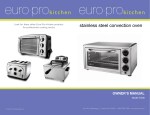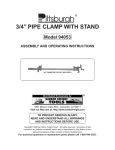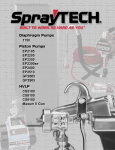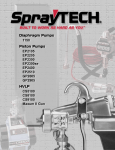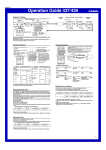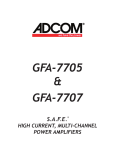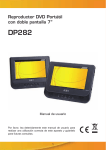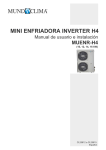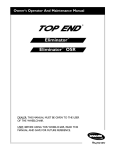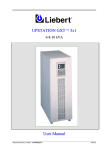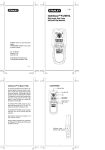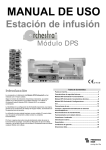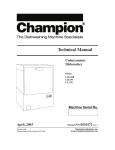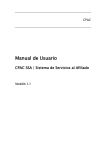Download Wagner SprayTech 505 User's Manual
Transcript
R 505 HIGH PERFORMANCE AIRLESS SPRAYER OWNER'S MANUAL Easy Does It From Set Up to Clean Up Read Warnings Assemble Cart Attach Tip to Gun Attach Return Hose Attach Paint Hose Prepare to Prime Attach Suction Set Prime Pump Set Pressure Spray Short Term Storage OR Clean Up Questions? ... Need Help? Wagner maintains a toll-free help line for you should you have any comments or problems with this Wagner product. Call us first ....for answers fast... Maintenance PRINTED IN THE U. S. A. Wagner Technical Service 1-800-328-8251 Hours: Weekdays: 8:00 - 4:30 Central Time Weekends: 9:00 - 4:00 Central Time Optional Hopper Accessory 1 Form No. 0270993-11/93 CONTENTS General Description ....................................................... 2 Safety Precautions ...................................................... 3-6 Extension Cord............................................................... 7 Grounding Instructions ................................................... 7 Pressure Relief Procedure ............................................. 8 Set Up ....................................................................... 9-11 Priming .................................................................... 12-14 Spraying .................................................................. 15-18 Short Term Storage ...................................................... 19 Cleanup and Long Term Shutdown ........................ 20-22 Maintenance ........................................................... 23, 24 Optional Hopper ........................................................... 25 Trouble Shooting .................................................... 26, 27 Parts Lists ............................................................... 28-30 Accessories List ........................................................... 31 Warranty ........................................................ Back Cover Components: The shipping carton for your 505 Painting System contains the following components: Cart frame with wheels, motor and pump attached. Cart handle Spare Outlet Spring, P/N 0047485 Pail bracket/cart foot Spare Tip Seal , P/N 0156713 Suction set and return tube Return tube fitting , P/N 0088715 Spray gun and filter Operator’s manual Spray tip and gasket Three bolts, washers and wing nuts ARE LOCATED IN THE 25-foot 3/16-inch higher pressure hose LITERATURE SET WITH REGISTRATION CARD General Description The Wagner 505 High Performance Airless Sprayer is a precision power tool used for spraying many types of materials. It is a relatively simple machine to operate, however, a basic understanding of its components is necessary. Read and follow this instruction manual carefully for proper operating instructions, maintenance and safety information. Specifications Weight: ................................................... 27 lbs. (12 kg ) Capacity: ............................................... Up to 1/3 gallon (1-1/4 liters) per minute Power Source: ............................ 1/3 HP Electric Motor, totally enclosed, fan cooled. Power Requirement: ......................... 15 amp minimum circuit on 115 VAC, 60 HZ current. Generator – 15 amp A/C. Spraying Pressure: .............................. Up to 2,500 psi. Safety Features: .................. Spray gun safety lock and pressure diffuser; built-in tip safety guard; priming knob for safe pressure release. Portability: ........................ Compact design, light weight for easy movement. Capability: ............................ Sprays a variety of paints, oil base, latex, primers, stains, preservatives and other nonabrasive materials, including pesticides and liquid fertilizers. Hydraulic Pump Pressure Control Knob Priming Knob Paint Block Suction Set Paint Hose On/Off Switch Spray Gun Figure 1 – Wagner 505 Airless Sprayer 2 SAFETY PRECAUTIONS This manual contains information which must be read and understood before using the equipment. When you come to an area which has one of the following symbols, pay particular attention and make certain to heed the safeguard. WARNING Important safety information indicates a hazard which may cause serious injury or loss of life. CAUTION Important information that tells how to prevent damage to equipment or how to avoid causes of minor injuries. Notes: Gives important information which should be given special attention. CAUTION THIS UNIT IS PROVIDED WITH A THERMALLY PROTECTED AUTOMATIC RESET. IF AN OVERLOAD OCCURS THE THERMALLY PROTECTED AUTOMATIC RESET DISCONNECTS THE MOTOR FROM THE POWER SUPPLY. • Motor will restart without warning when protector automatically resets. • Always disconnect motor from power supply before working on equipment. • When thermally protected automatic reset disconnects the motor from the power supply, relieve pressure by turning priming valve to "prime" A . • Turn ON-OFF switch OFF. CAUTION: THE CAUSE OF THE OVERLOAD SHOULD BE CORRECTED BEFORE RESTARTING. (SEE TROUBLE SHOOTING ) 3 WARNING HAZARD PREVENTION Injection Injury - A high pressure stream of paint produced by this equipment can pierce the skin and underlying tissues, leading to serious injury and possible amputation. • Maximum operating range of the gun - 2500 PSI fluid pressure. • NEVER aim the gun at any part of the body. • NEVER allow any part of the body to come in contact with the fluid stream. DO NOT come in contact with a fluid stream created by a leak in the fluid hose. • NEVER put hand in front of the gun. Gloves will NOT provide protection against an injection injury. • ALWAYS lock the gun trigger,shut fluid pump off and release all pressure before servicing, cleaning tip guard, changing tips, or leaving unattended. Simply turning off the electrical power will not release pressure in the system. The Prime Spray Valve must be turned to the prime A position to relieve the pressure. • ALWAYS have the tip guard in place while spraying. The tip guard provides some protection against injection injuries but is mainly a warning device. • ALWAYS remove spray tip before flushing or cleaning the system. Refer to Cleaning Instructions. DO NOT TREAT AS A SIMPLE CUT! Injectioncan lead to amputation. See a physician immediately. • Paint hose can develop leaks from wear, kinking, abuse etc. A leak is capable of injecting material into the skin. The paint hose should be inspected before each use. NOTE TO PHYSICIAN: Injection into the skin is a traumatic injury. It is important to treat the injury surgically as soon as possible. DO NOT delay treatment to research toxicity. Toxicity is a concern with some coatings injected directly into the blood stream. Consultation with a plastic surgeon or reconstructive hand surgeon may be advisable. • NEVER use a spray gun which does not have a trigger lock and trigger guard in place and in working order. • All accessories must be rated at or above 2500 P.S.I. (Includes spray tips, guns, extensions, and hose). • In case of skin injection see physician immediately. 4 WARNING HAZARD PREVENTION Explosion or fire - Solvent and paint fumes can explode or ignite, causing property damage and or severe injury. • Exhaust and fresh air introduction must be provided to keep the air within the spray area free from accumulation of flammable vapors. • Avoid all ignition sources such as static electricity sparks, open flames such as pilot lights, hot objects such as cigarettes, and sparks from connecting and disconnecting power cords and working light switches. • Fire extinguishing equipment must be present and in working order. • Keep the pump away from spray area to avoid solvent and paint fumes. The pump contains arcing parts which emit sparks. • Do not spray paints and other inflammable fluids which have a flashpoint below 21° C (70° F). (Flashpoint is the temperature at which a fluid begins giving off a sufficient amount of flammable vapor that could ignite when exposed to a flame or spark.) • High velocity flow of material through equipment may develop static electricity. The equipment being used, and objects in and around the spray area must be properly grounded to prevent static discharge and sparks. • Use only conductive or grounded high pressure fluid hoses for airless applications. Be sure that gun is grounded through hose connections. • Power cord must be connected to a grounded circuit. (See proper grounding instructions.) • Follow the material and solvent manufacturer's safety precautions and warnings. • WHEN FLUSHING EQUIPMENT use lowest possible pressure. 5 WARNING PREVENTION HAZARD Explosion hazard incompatible materials - May cause property damage or severe injury. • DO NOT USE BLEACH. • DO NOT use halogenated hydrocarbon solvents. • Halogenated hydrocarbon solvents such as methylene chloride and 1,1,1 - Trichlorethane are not compatible with aluminum and may cause an explosion. If unsure of a material’s compatibility with aluminum, contact your coatings supplier. Hazardous vapors - Paints, solvents, insecticides, and other materials may be harmful if inhaled causing severe nausea, fainting, or poisoning. • Use a respirator or mask whenever there is a chance that vapors may be inhaled. Read all instructions with the mask to insure that it will provide the necessary protection against the inhalation of harmful vapors. General - May cause property damage or severe injury. • Read all instructions and safety precautions before operating. • Comply with all appropriate local, state and national codes governing ventilation, fire prevention, and operation. • The United States Government Safety Standards have been adopted under Occupational Safety and Health Act. These standards, particularly the General Standards, Part 1910 and construction Standard, Part 1926, should be consulted. • This high pressure airless pump is designed to be used with authorized parts only. When using this pump with parts that do not comply with the minimum specifications and safety devices of the pump manufacturer, the user assumes all risks and liabilities. • Before each use, check all hoses for cuts, leaks, abrasion or bulging of cover or damage or movement of couplings. If any of these conditions exist, replace the hose immediately. Never repair a paint hose. Replace it with another grounded hose. • All hoses, swivels, guns, and accessories used with this unit must be pressure rated at or above 2500 PSI. • DO NOT spray on windy days. 6 Extension Cord This product is for use on a nominal 120 volt circuit, and has a grounding plug that looks like plug illustrated in Figure 2 (A) below. A temporary adapter which looks like the adapter illustrated in Figure 2 (B) and (C), may be used to connect this plug to a 2 pole receptacle as shown in Figure 2 (B) if a properly grounded outlet is not available. The temporary adapter should be used only until a properly grounded outlet as shown in Figure 2 (A) can be installed by a qualified electrician. The green colored rigid ear lug, or the like extending from the adapter must be connected to a permanent ground such as a properly grounded outlet box cover. Whenever the adapter is used, it must be held in place by a metal screw. Use only a 3-wire extension cord that has a 3-blade grounding plug and a 3-slot receptacle that will accept the plug on the product. Make sure your extension cord is in good condition. When using an extension cord, be sure to use one heavy enough to carry the current your product will draw. An undersized cord will cause a drop in line voltage resulting in loss of power and overheating. A 14 or 12 gauge cord is recommended. NOTE: More than 100 feet of extension cord is not recommended. Use more paint hose, not more extension cord. Shorter extension cords will assure maximum electrical power for proper operation. Grounded Outlet Grounding Instructions This product must be grounded. In the event of an electrical short circuit, grounding reduces the risk of electric shock by providing an escape wire for the electric current. This product is equipped with a cord having a grounding wire with an appropriate grounding plug. The plug must be plugged into an outlet that is properly installed and grounded in accordance with all local codes and ordinances. WARNING Grounding Pin (A) Cover of Grounded Outlet Box Adapter Metal Screw Improper installation of the grounding plug can result in a risk of electric shock. (C) If repair or replacement of the cord or plug is necessary, do not connect the green grounding wire to either flat blade terminal. The wire with insulation having an outer surface that is green with or without yellow stripes is the grounding wire and must be connected to grounding pin. (B) Tab for Grounding Screw Figure 2 – Grounding Methods Check with a qualified electrician or serviceman if the grounding instructions are not completely understood, or if in doubt as to whether the product is properly grounded. Do not modify the plug provided; if it will not fit the outlet, have the proper outlet installed by a qualified electrician. 7 Pressure Relief Procedure Follow this procedure after the unit is assembled and before any operation which involves the spray gun such as changing tips or accessories, or cleaning and maintenance. 3. Trigger gun to remove any pressure which may still be in the hose. 1. Make sure PRESSURE CONTROL KNOB is at its lowest setting (counterclockwise). Pressure Control Knob 2. Turn PRIMING KNOB to PRIME A position. 4. Lock gun trigger in the Off position. Prime A Spray B Knob Trigger Lock Injection hazard possible. Do WARNING not spray without tip guard in place. NEVER trigger gun unless tip is completely turned to the spray or unclog position. ALWAYS engage trigger lock before removing, replacing or cleaning tip. 8 SET-UP ASSEMBLE CART Tools needed: Some assembly is required to get your Wagner 505 Airless Sprayer ready to go. You will need two adjustable wrenches, a screw driver and a pair of pliers. Pail Bracket NOTE: Sprayer should remain unplugged during assembly. 1. Slide pail bracket (1) onto cart frame and attach with one bolt, washer and wing nut (2). See Figure 2 and Figure 3 A. This bracket helps to keep the sprayer stable in addition to providing a rest for the paint bucket and a catch for the bucket handle. Bolt, washer and wing nut Figure 3A - Attaching Pail Bracket 4 2. Attach cart handle (3). Face the hose hook toward the front of the unit. Use two bolts, washers and wing nuts (4), tightening securely. See Figure 3B. 3 Cart Handle Bolt, washer and wing nut 2 1 Figure 2 – Cart Assembly Diagram Figure 3B - Attaching Cart Handle 9 SET-UP ATTACH TIP TO GUN 3. Check seal alignment by removing tip and inspecting tip guard visually, See Figure 6. If needed, remove seal (3) and replace until properly aligned. Replace tip to spray position, (arrow away from gun). Insert red seal (4). 1. Lock gun. See Figure 4. Locked Position Unlocked Position Figure 4 - Gun in Locked & Unlocked Position Correct Way 2. If spray tip is not pre- assembled, (See Figure 5) insert tip (1) into tip guard, (2) and turn 90° counterclockwise to spray position (arrow pointing away from gun). Cylinder of tip forms a stop for the seal (3). Insert seal (3) aligning the curve of the seal with the curve of the tip. 3 Wrong Way Figure 6 - Spray Tip Assembly 4. Attach spray tip to gun. Tighten nut first by hand, then tighten with a wrench. See Figure 7. 4 2 Red Seal 1 Figure 7- Attach Tip to Gun NOTE: When attaching tip to gun, align tip guard as Figure 5 – Spray Tip Assembly shown in Figure 8. Then tighten with wrench. INJECTION WARNING POSSIBLE HAZARD. Do not spray without tip guard in place. Never trigger gun unless tip is in the spray or unclog position. Always engage trigger lock before removing, replacing or cleaning tip. Figure 8 - Vertical Tip Pattern 10 SET-UP ATTACH RETURN HOSE ATTACH PAINT HOSE 1. Be sure motor switch is turned OFF. 2. Screw brass fitting of return tube into upper port on side of pump. (The brass fitting is located in the literature set.) Tighten firmly by hand. See figure above. 1. Attach high pressure hose to hose port, using an adjustable wrench to tighten firmly. (See illustration above.) 2. Attach gun to other end of high pressure hose. Tighten securely with two adjustable wrenches. See Figure 10. 3. Press return tube (small tube) to brass fitting and fasten with clamp. See Figure 9. Figure 10 - Attaching High Pressure Hose to Gun. Figure 9 - Fastening Return Tube with Clamp 3. Plug unit into a properly grounded outlet or heavy duty grounded extension cord. Do not use more than 100 feet of cord. If you must spray a long distance from a power source, use more paint hose, not more extension cords. Use a minimum size of 16 gauge electric cord for 50 feet; 12-14 gauge for 100 feet. 11 PRIMING PREPARE TO PRIME 4. Force the inlet valve to open and close by pushing on it with the eraser end of a pencil or screwdriver, it should move up and down about 1/16 inch. Continue until water or oil is sucked into unit. This will assist in wetting the moving parts and breaking loose any old paint residue. See Figure 13. 1. Lay unit back on its handle so inlet valve is facing up. Fill inlet valve with water or light household oil. 2. Make sure Prime/Spray Knob is in Prime A position and Pressure Knob is turned to the lowest pressure. (Counter clockwise) See Figure 11. Turn unit on. Inlet Valve Facing Up PrimeA /Spray B Knob Hose Port Figure 13 - Opening Inlet Valve 5. Put palm of hand over inlet valve and feel for a slight suction while increasing the pressure control to the maximum setting. See Figure 14. If suction is felt go to step 6. If no suction is felt see Cleaning and Servicing Outlet Valve. ( Repeat steps 1 through 5 if necessary.) Figure 11 - Prime/Spray Knob 3. Increase pressure half turn. Pressure Control Knob Figure 14 - Checking for Suction Figure 12 - Pressure Control Knob 6. Turn Pressure Control Knob to minimum pressure and shut off unit. 7. Return unit to upright position. 12 PRIMING PRIME THE PUMP ATTACH SUCTION SET 1. Attach Suction Tube to inlet valve and tighten firmly by hand. See Figure 15. Be sure threads are straight so the fitting turns freely without binding. 1. Make sure the PRESSURE CONTROL KNOB is at its lowest setting (counterclockwise). See Figure 18. (Do Not cross thread) Pressure Control Knob Figure 15 - Attaching Suction Tube 2. Place suction tube and return tube in paint. See Figure 16. Figure 18 - Set Pressure Control Knob 2. Turn PRIMING KNOB to Prime A position. See Figure 19. Figure 16 - Place Suction Tube and Return Tube in Paint. Prime A Spray B Knob 3. Set paint bucket onto pail bracket and attach handle. See Figure 17. Figure 19 - Priming Knob Setting Figure 17 - Attaching Paint Pail Handle 13 13 PRIMING PRIME THE PUMP Continued from page 13 3. TURN SPRAYER ON. Always reduce pressure to zero before changing the position of the priming knob. Failure to do so may cause damage to the paint pump diaphragm. CAUTION 4. Turn PRESSURE CONTROL KNOB between half and full pressure. See Figure 20. You should then be able to see the paint move through the suction tube to the pump. Continue until paint flows through the return tube. (Let unit prime 1 to 2 minutes). If the Pressure Control Knob is reduced to zero and the Priming Knob is still on spray during sprayer operation, there will be high pressure in the hose and spray gun until the Priming Knob is turned to PRIME A or until the spray gun is triggered to relieve the pressure. CAUTION Figure 20 - Turn Pressure Control Knob 14 SPRAYING PRACTICE FIRST 1. Be sure paint hose is free of kinks and clear of traffic or objects with sharp cutting edges. 2. Return PRESSURE CONTROL KNOB to its lowest setting (counterclockwise). Figure 21. Figure 23 - Practice on scrap material. 5. Unlock SPRAY GUN TRIGGER LOCK by turning lock down toward the bottom of the handle. Figure 4 6. Trigger spray gun to bleed air out of hose. 7. When paint reaches spray tip, spray a test area to check spray pattern. See Figure 23. Figure 21 - Pressure Control Knob Setting 3. Turn PRIMING KNOB to SPRAY B position. Figure 22. 8. Use the lowest pressure setting necessary to get a good spray pattern. If pressure is too high, material is over-atomized. If pressure is too low, tailing will appear or paint will spatter out in gobs rather than in a fine spray. See Figure 24. Most latex paints and stains will require very high pressure, which is why the sprayer is built to deliver up to 2,500 psi when needed. PrimeA Spray B Knob GOOD SPRAY PATTERN Figure 22 - Priming Knob Setting 4. Turn PRESSURE CONTROL KNOB completely clockwise to maximum pressure, Figure 21. Paint should then begin to flow into the paint hose, causing it to stiffen. Figure 24 - Paint Tailing Pattern 15 SPRAYING SPRAYING TECHNIQUE 1. The key to a good paint job is an even coating over the entire surface. With spray painting, this is done by using even strokes, with your arm moving at a constant speed and keeping the spray gun a constant distance from the surface. Even Coat on Work Throughout Approximately Approximatley 10toto12 12Inches Inches 10 2. In most cases, the best spraying distance is 10 to 12 inches between the spray tip and the surface. 3. As much as possible, keep the spray gun at right angles to the surface. This means moving your entire arm back and forth rather than just flexing your wrist. See Figures 25 and 26. Right Way To Spray Steady Arm Figure 26 - Result of smooth arm stroke and steady, even speed while spraying. 4. Keep the spray gun perpendicular to the surface, otherwise one end of the pattern will be thicker than the other. See Figure 27. Approximately 10 to 12 Inches Right Way Wrong Way Figure 25 - Result of Flexing Wrist While Spraying Figure 27 - Right and wrong ways to hold spray gun toward work. 16 SPRAYING 5. The spray gun should be triggered off at the end of each stroke and on again at the beginning of the next. This avoids paint buildup at the end of the stroke which may result in runs and sags. Triggering at the end of the stroke also saves paint and results in a better looking job. See Figure 28. Approximately Approximatley 10 10 to to 12 12 Inches Inches If Spray Tip Becomes Clogged The spray gun is equipped with a reversible tip which enables you to quickly and effectively blow out any particles of old paint or other contaminants that may obstruct the paint flow through the tip. If the spray pattern becomes distorted or stops completely while the gun is triggered on, follow these steps. Work 1. Release the trigger and put on the safety lock. See Figure 4. Even Steady Stroke Start Stroke Pull Trigger 2. Rotate the reversible tip cylinder arrow 180° so the point of the arrow is toward the rear of the gun. Figure 29. End Stroke Release Trigger Figure 28 - Proper Way to Trigger Spray Gun 6. Overlap each stroke by about 30%. This will assure a paint coating that is uniform across the work. One way to do this is to point the spray tip at the edge of the last stroke before triggering the gun on. 7. When taking a short break from painting (up to 1 hr.), lock the spray gun trigger OFF, reduce pressure to its minimum (zero) setting and set the unit to prime A . Turn sprayer off and unplug. Refer to Pressure Relief Procedure. Figure 29 - Reverse Tip 3. Unlock the trigger and squeeze it open, pointing the gun at a scrap piece of wood or cardboard. This allows pressure in the paint hose to blow out the obstruction. When the nozzle is clean, paint will come out in a straight, high pressure stream. 8. If you expect to be gone more than 1 hour follow the short term clean up procedure. 4. Release the trigger and re-lock it. Figure 4 5. Reverse the tip so the arrow points forward again. 6. Unlock the trigger and resume spraying. 17 SPRAYING Continued from page 17 6. Insert the top of the filter (Figure 30) into the gun body fitting under the tip of the spray gun. See Figure 31. Cleaning The Spray Gun Filter The spray gun includes a filter to catch particles before they reach the spray tip. If this filter becomes clogged or obstructed it will reduce the flow of paint, changing the spray pattern and possibly damaging the filter. This filter must be cleaned at least daily and perhaps even every four hours with certain types of latex materials. Spring If the filter is not cleaned at the proper time, it will plug from the top down. When there is about 1 inch of filter that isn't plugged, the heavy flow of paint will blow pin holes in the filter. See Figure 30. This in turn will allow unwanted particles to get into the spray tip, causing spray tip to clog. Gun Body Fitting Filter Top of Filter Sealing Washer Filter Housing Figure 31 - Gun Filter Cleaning. 7. Replace the spring and sealing washer into the base of the filter housing. 8. Slide the filter housing over the filter and tighten it securely to the gun, using a wrench. Pin Hole 9. Reattach the hose, tightening it securely with two wrenches. Figure 30 - Gun Filter Cleaning. 10. Turn PRIMING KNOB to SPRAY B , (Figure 10) increase pressure to its previous setting and resume spraying. To clean the filter during the painting process: 1. Turn spray PRESSURE CONTROL KNOB to minimum setting and turn PRIMING KNOB to PRIME A . This will bleed off the pressure in the paint hose and filter. Trigger gun to be sure pressure is gone. Refer to Pressure Relief Procedure. Suction Set Screen The screen at the bottom of the suction set may also need cleaning periodically. Check it every time you change paint buckets. Remove screen by pulling it out of the retainer with a pliers. Clean the screen with water or solvent and a soft-bristle brush, if needed. 2. Remove spray gun from hose using two adjustable wrenches. See Figure 10 3. Unscrew filter housing, using adjustable wrench on the nut at the bottom of the housing. 4. Remove filter being sure not to lose the spring and sealing washer which is located in the bottom of the filter housing. 5. Clean filter thoroughly (or put in a new filter). To clean the filter, swish it in water or the type of solvent appropriate to the paint you are using. If this isn’t sufficient, use a natural or nylon bristle brush dipped in the appropriate solvent or water. Do not use a wire brush or any sharp instrument. Figure 32 - Remove And Clean Screen 18 CLEAN UP SHORT-TERM/OVERNIGHT STORAGE Shut-down Start-up 1. Lock the gun and reduce the pressure. Turn the sprayer to prime A and shut it off. Unplug sprayer. Leave the suction set in the paint. Refer to Pressure Relief Procedure. 1. Remove the gun from the plastic bag. 2. Stir the water into the paint for latex materials. Remove the seal from the paint bucket and stir the paint for all other materials. 2. For latex materials only, pour 1/2 cup water slowly on the top of the paint to prevent the paint from drying. For other materials, seal the paint container with a piece of plastic while the suction tube is still in the paint. See Figure 33. – OR – Figure 35 - Stir Material Before Spraying 3. Check to be sure the sprayer is in the Prime A position with the pressure completely reduced. Figure 33 – Add 1/2 Cup Water to Latex Paint Seal Container for Other Materials. 4. Plug sprayer in and turn on. 3. Wrap the spray gun (completely assembled) in a damp cloth and place it in a plastic bag. Seal the bag shut. See Figure 34. 5. Turn the sprayer to Spray B and gradually increase the pressure. 6. Test the sprayer on a practice piece and begin spraying. Figure 34 - Place Gun in Sealed Bag 4. Place the sprayer in a safe place out of the sun for short-term storage. Figure 36 - Test on scrap material. 19 CLEANUP SHUT DOWN/CLEAN UP 9. To save paint left in the hose, carefully trigger the gun (with spray tip removed) against the inside of the paint container. See Figure 37. Reduce PRESSURE CONTROL KNOB to zero, then turn PRIMING KNOB to SPRAY B . Do not allow paint to build up on Overheating of the motor will result. Do not allow flammable solvents to come in contact with the motor, which could ignite. WARNING the motor. NOTE: You will need an extra bucket with cleaning solution, a toothbrush, an adjustable wrench and rags. 1. Lock the gun and reduce the pressure. Turn the sprayer to prime A and shut it off. Unplug sprayer. Leave the suction set in the paint. Refer to Pressure Relief Procedure. 2. Remove suction tube from paint and hold it above a bucket of water or solvent. Leave the return tube aimed into the paint bucket. Figure 37 - Save Paint Back To Paint Can. 3. If spraying with latex paint, use warm soapy water for cleaning. If using oil or alkyd-based paints, use mineral spirits or paint thinner. Do not use these solvents on latex paint, or the mixture will turn into a jelly-like substance which is difficult to remove. Plug the unit in and turn on. 10. Increase PRESSURE CONTROL KNOB again until paint starts to flow into the bucket. As soon as the water or solvent starts to come into the bucket, release the trigger. 11. Change to clean water or solvent and continue circulating for another 5 minutes to thoroughly clean the hose, pump and spray gun. 4. Increase PRESSURE CONTROL KNOB clockwise to about 1/3 to 1/2 maximum pressure. This will draw the remaining paint in the suction tube through the pump and down the return tube into the paint bucket. 12. Reduce pressure and turn to prime A . Trigger gun. Lock gun and shut sprayer off. 5. Set PRESSURE CONTROL KNOB counterclockwise back to minimum pressure. Trigger gun to relieve pressure and lock gun. 13. Remove spray gun from paint hose, using two adjustable wrenches. Remove filter housing from gun. Place gun and filter assembly into a container of water or solvent to soak. Cover paint container and set it aside. 6. Remove spray tip and guard, washer, and let soak in warm water or appropriate solvent. 7. Place suction tube and return tube in container of water or compatible solvent. 8. Increase pressure to about 1/2 maximum pressure and let circulate for 2-3 minutes to flush paint out of the pump, suction tube and return tube. 20 CLEAN UP 14. Clean spray tip and gun filter with a soft brush. Reassemble spray tip in cleaning position. (Arrow points to back of the gun.) 16. Turn the unit on and unlock gun trigger. Turn to Spray B and point gun to side of cleaning bucket. Figure 41 - Cleaning Bucket 17. Trigger gun and gradually turn pressure knob clockwise to 1/2 pressure. Continue for approximately 30 seconds. 18. Release and lock trigger, reduce pressure, turn to prime A . Turn unit off. 19. Remove tip assembly. Raise the suction set above the cleaning solution. Turn unit on, turn to spray B increase pressure and allow suction tube to run dry. 15. Attach paint hose to gun,tighten with two wrenches. 20. Remove large suction tube from inlet valve, See Figure 42 and point gun into cleaning bucket, See Figure 41. Reduce pressure about 1/2, unlock gun, trigger gun until hose is pumped dry. Figure 40 - Attach Paint Hose to Gun Figure 42 - Removing Large Suction Tube 21 CLEAN UP 23. Turn Prime/Spray Knob to prime A , reduce pressure, shut sprayer off. Unplug sprayer. Refer to Pressure Relief. 24. Remove and clean suction set filter in clean water or solvent with soft brush. Reassemble. 21. Lock gun, reduce pressure and turn Prime/Spray Knob to prime A . 22. Lay unit back on handle so inlet valve is facing upward. Clean threads of inlet valve with a damp cloth. Fill inlet valve with light household oil. See Figure 43. Slowly increase pressure to distribute the oil through the pump. Turn Prime/Spray Knob from prime A to spray B to distribute oil. Replace large suction tube to inlet valve. Figure 43 - Fill Inlet Valve With Oil Figure 44 - Remove And Clean Filter 25. Wipe entire unit, hose and gun with a damp cloth to remove accumulated paint. IMPORTANT! Proper cleaning and oiling of the pump after use are the most important steps you can take to insure proper operation after storage. 22 MAINTENANCE CLEANING VALVES Follow these procedures when encountering problems indicated in the trouble shooting section. NOTE: The inlet valve must be oiled after every job. This will reduce or eliminate priming problems the next time the sprayer is used. See Figure 43. Removing and Cleaning Inlet Valve 4. Thoroughly clean the valve assembly with solvent and brush. 1. Be sure sprayer is off. 5. A properly seated valve filled with water and held vertically will not drip out the bottom of the valve. If you have properly cleaned the valve and water drips out the bottom, the valve is worn and needs to be replaced. 2. Using a 27 millimeter socket or box end wrench, remove the inlet valve assembly. Remove Inlet Valve 6. Install cleaned or new valve in the pump block and then fill the valve with light oil or solvent. 7. If none of the above steps work, see Troubleshooting. Cleaning and Servicing Outlet Valve Figure 45- Removing Inlet Valve 3. Test movement of the valve by pushing on it from the open end of the valve housing with the eraser end of a pencil or a screwdriver. It should move about 1/16 inch. If it doesn't move, it is probably full of dry paint or other debris and should be cleaned or replaced. It may be occasionally necessary to remove and clean the outlet valve or replace normal wear parts inside the valve. See Figures 47 and Figure 48. 1. Remove outlet cap with adjustable wrench. Outlet Valve Figure 47 - Removing Outlet Valve Figure 46 - Test Movement of Valve 23 MAINTENANCE CLEANING VALVES 2. If possible, leave the copper washer under the cap in place. At least be sure to replace it with the same side up. (The top will show the imprint of the end cap, while the bottom should be perfectly flat to match seat in the pump casting.) See Paint Pump Assembly Parts Diagram,Item 4 for replacement part number. A spare outlet valve spring is included in the litSpring erature set. Cap Ball Seat Seal 3. With a wire hook or tweezers, remove the small spring inside the valve. Replace if broken, or worn or clean as necessary. See Paint Pump Assembly Parts Diagram, Item 4 for replacement part number. This spring is manufactured to a very specific tension, so do not put in an unauthorized subsitute. Proper spring length is 7-1/2 coils. 4. Using a six-millimeter allen wrench, remove the seat and ball assembly. See Figure 48. 5. Clean parts thoroughly. If the ball or seat show any sign of wear or damage, replace it with a new one. This carbide ball must seal tightly against its seat for the valve to function properly. Figure 48 - Servicing Outlet Valve NOTE: Wear on the ball is almost impossible to detect visually. A sure way to test for a worn outlet valve assembly is to run the sprayer with water only for 10 to 15 minutes on high pressure in the spray setting without triggering the gun. 6. When reassembling, first cover all parts with a thin coat of light oil. Tighten the valve seat securely with the 6-millimeter hexagonal wrench, then drop in the valve ball. Re-insert the spring and replace the cap, being sure the copper washer is in place and the tongue on the cap fits inside the spring. Tighten the cap securely with an adjustable wrench. Do not over-tighten. If the valve is defective, the end cap will get very hot to the touch. If it is functioning properly, it will stay approximately the same temperature as the water running through it. Priming Knob Slippage Sometimes the two allen screws holding the black plastic PRIMING KNOB outer cover will vibrate loose. This allows the knob to turn without changing the valve setting. If this happens, loosen the screw with a 1/16 allen wrench, turn the knob to spray and retighten. 24 OPTIONAL HOPPER ASSEMBLY CONVERTING SPRAYER FOR HOPPER OPERATION The hopper assembly consists of the hopper, hopper return tube and hopper screen. To make the conversion: 1. Remove suction tube and return tube and brass return tube fitting from the unit. 2. To convert the cart into its horizontal configuration as shown in Figure 49, reverse the positions of the handle and pail bracket. 3. Screw the hopper directly onto the inlet valve where the suction tube was removed. Make the connection hand tight, just tight enough to prevent paint leakage or air suction around the threads. 4. Screw in the plastic return tube fitting into the paint pump port that the brass fitting was removed from. Attach hopper return tube to the fitting where the suction set return tube was removed. The connection needs to be only hand tight. 5. Fit the hopper screen into the bottom of the hopper, being sure it is properly seated. NOTE: The hopper screen is essential to trap debris and other foreign objects from entering the pump. Do not operate the sprayer without the screen properly in place. Hopper Return Tube Cleaning Hopper Unit To clean the hopper unit: Hopper 1. Flush the pump and hose with water or solvent following the same procedure as with the suction tube, being sure the return tube is thoroughly flushed out. 2. Clean the hopper screen with water or appropriate solvent. If necessary use a nylon or natural bristle brush dipped in solvent or soapy water. 3. Wash the hopper thoroughly using soapy water for latex paint, the appropriate solvent with other materials. Figure 49 - Optional Hopper 25 TROUBLE SHOOTING Problem Cause Remedy Sprayer does not start up. Sprayer not plugged in. ON/OFF switch OFF. Blown fuse in circuit. No voltage or low voltage at wall plug. Unit turned off under pressure. Damaged motor cord or extension cord, or capacity too low. Thermal overload tripped Motor problem. Plug in. Flip switch to ON. Replace fuse. Test power supply voltage. Sprayer starts up but does not draw in paint. (Make sure prime/ spray knob is in prime position.) Unit will not prime or has lost prime. No paint. Suction tube not totally immersed in paint. Suction set filter clogged. Hopper screen clogged Suction tube loose at inlet valve. Inlet valve stuck. Outlet valve stuck. Prime spray valve plugged or dirty. Inlet valve worn or damaged. Diaphragm problem. Hydraulic oil level low or empty. Sprayer draws up paint but drops away when gun is opened. Turn Prime/Spray Knob to Prime position. Replace extension cord. Allow motor to cool,move to a shady spot. Take to Wagner Authorized Service Center. Reprime Unit. Immerse suction tube in paint. Clean filter. Clean screen. Clean connection and tighten. Clean inlet valve. Clean outlet valve. Replace any worn parts. Take to Wagner Authorized Service Center. Clean or replace. Take to Wagner Authorized Service Center. Take to Wagner Authorized Service Center. Worn spray tip Suction set filter clogged. Optional hopper screen clogged. Gun or spray tip filter plugged. Replace with new tip. Clean filter. Clean screen. Clean or replace filter. Keep extra filters on hand. Paint too heavy or coarse. Thin or strain paint. Dirty or worn outlet valve assembly. Clean or replace. Inlet valve worn or damaged. Replace valve. NOTE: The electric motor should always be kept clean and dry. Paint acts as an insulator, therefore too much paint on the motor will cause the motor to overheat. NOTE: When priming valve is on Spray B and there is flow through the return tube, remove the priming valve and clean or replace. 26 TROUBLE SHOOTING Problem Cause Remedy Spray gun won't shut off. Worn ball or seat. Foreign matter or paint buildup or dried paint between ball and seat. (Caused by improper cleaning of gun. Take to Authorized Wagner Service Center. Take to Authorized Wagner Service Center. Spray gun leaks. Worn or dirty internal parts. (Caused by improper cleaning of gun.) Take to Authorized Wagner Service Center. Tip assembly leaks Assembled incorrectly. Worn seal. Check assembly. Replace seal. Spray gun won't spray. Spray tip, gun filter or tip filter plugged. Clean spray tip. Clean or replace gun filter. Clean or replace tip filter. Put tip in Spray position. Spray tip in Clean position. Paint tailing. Thermal overload tripped WARNING Pressure is set too low. Increase pressure. Gun, tip,or suction filter plugged. Clean filters Suction tube loose at Tighten suction tube fitting. inlet valve. Tip worn. Paint too thick Replace tip. Thin paint Motor over heated. Extension cord too long or too small gauge. Paint build up on motor. Restart under pressure . Unit sitting in hot sun. Allow to cool 15 to 30 min. Allow to cool, replace cord with one shorter or larger gauge. Clean paint from motor. Restart in Prime mode. Move to a shady location. Follow Pressure Relief Procedure before performing any of these operations since the motor will restart without warning when the motor cools sufficiently 27 1 2 9 3 11 4 10 5 Serial Number Location 6 9 7 8 3 4 Parts Diagram – Final Assembly ITEM PART NO. 1 2 3 4 5 6 0288478 0270357 9821503 9810111 0270356 0270359 DESCRIPTION Grip, Handle Handle, Cart Washer, Lock Nut, Wing Cart Assembly Wheel QTY. 1 1 4 2 1 2 ITEM PART NO. DESCRIPTION 7 8 9 10 0275728 0270358 9800117 ----------- 11 0288186 Cap, Hub Bracket, Pail Bolt, 1/4-20 x 1-1/2 Paint Pump Assembly (See Parts Diagram, Page 29) Housing, Hydraulic 28 QTY. 2 1 3 1 1 1 2 3 4 5 12 6 7 Never remove these four bolts! Take to an Authorized Wagner Service Center. CAUTION 3 11 8 10 9 Parts Diagram – Paint Pump Assembly ITEM PART NO. DESCRIPTION 1 0281113 2 3 4 5 6 0089564 9970103 0047485 0093635 0090348 Valve, Inlet Assembly (includes item 12) Cap, Outlet Assembly Washer, Sealing, Copper Spring, Outlet Ball, 6mm, Carbide Seat, Ball, Outlet Assembly QTY. ITEM PART NO. DESCRIPTION 1 7 8 9 10 11 12 1 2 1 1 1 29 QTY. 0089494 0288379 0088715 0288748 0090533 0089482 Seal, Outlet Fitting, Outlet Fitting, Return Tube Knob Only Paint Pump with Valve Washer, Sealing, Nylon 1 1 1 1 1 1 0288172 Repair Kit Replaces both Holder & Seat 1 2 11 3 10 12 9 4 5 6 1 5 7 8 Parts Diagram – Suction Set Assembly 0270174 ITEM PART NO. DESCRIPTION 1 0270133 2 3 4 5 6 0090622 0281314 0088931 0089882 0270360 Suction Tube Complete (Includes Items 2 thru 10) Nut, Suction Elbow, Adapter, 3/4" x 1" Ring, Snap Clamp Hose, Suction QTY. 1 1 1 1 2 1 ITEM PART NO. DESCRIPTION 7 8 9 10 11 12 30 0270371 0270369 0090621 0088715 0089096 0270363 Housing, Filter Filter Washer Fitting, Return Hose Clamp Tubing, Return QTY. 1 1 1 1 1 1 1 2 7 3 5 4 6 Parts Diagram – Optional Hopper Assembly ITEM PART NO. DESCRIPTION 1 0288144 2 3 0090283 0089917 0088871 QTY. Hopper, Complete (lncludes ltems 2 thru 7) Hopper Filter Screen, Fine (Shown) Filter Screen, Coarse ITEM PART NO. DESCRIPTION 1 4 0090560 1 1 5 6 7 0093865 0090617 0288668 Return Tube Assembly (lncludes ltems 5 & 6) Return Tube Fitting Cover, Hopper Accessories Part Number Description Part Number Description 0153000 0153001 0093896 0149018 0149017 0089731 0154675 0093820 Hose, 25' x 3/16", Grounded Hose, 50' x 3/16', Grounded Hose Connector G-09 Spray Gun G-10 Spray Gun Gun Filter Assembly Gun Filters, Medium/Fine Adjustable Tip 0154681 0154682 0154683 0154693 0155206 0155208 0088009 0088010 Reversible Tip (light), Stains Reversible Tip (Medium), Enamel Reversible Tip (Heavy), Latex Reversible Tip Repair Kit Roller Cover, 9" x 3/8" Nap Roller Cover, 9" x 3/4" Nap Hydraulic Oil (quart) Hydraulic Oil (gallon) 31 QTY. 1 1 1 1 Parts and Accessories 1 10 9 3 4 8 7 2 6 5 PARTS LIST Item Part No. 1 2 0293004 0089731 3 4 5 6 0043590 0089694 0089692 0089959 Description G-06 Gun Assembly Filter Assembly (Includes Items 3,4,5,6) Spring Seal, Nylon Housing Filter Filter Item Part No. 7 8 9 10 0293303 0154782 0154783 0154784 0154680 0154693 Description Guide, Hose Tip, .011 (Oil based materials) Tip, .013 (Oil based , latex paints and stains) Tip, .015 ( Extra thick materials) Tip, Body Seal Kit Part Numbers may change without notice due to improvements and modifications. 32 LIMITED WARRANTY AIRLESS PAINT SPRAY EQUIPMENT This product, manufactured by Wagner Spray Tech Corporation (Wagner), is warranted to the original retail purchaser against defects in material and workmanship for 30 days from date of purchase for professional/rental use if operated in accordance with Wagner's printed recommendations and instructions. This warranty applies for one year from date of purchase for home use. This warranty does not cover damage resulting from improper use, accidents, user's negligence or normal wear. This warranty does not cover any defects or damages caused by service or repair performed by anyone other than a Wagner Authorized Service Center. This warranty does not apply to accessories. ANY IMPLIED WARRANTY OF MERCHANTABILITY OR FITNESS FOR A PARTICULAR PURPOSE IS LIMITED TO 30 DAYS FOR PROFESSIONAL/RENTAL USE AND ONE YEAR FOR HOME USE FROM DATE OF PURCHASE. WAGNER SHALL NOT IN ANY EVENT BE LIABLE FOR ANY INCIDENTAL OR CONSEQUENTIAL DAMAGES OF ANY KIND, WHETHER FROM BREACH OF THIS WARRANTY OR ANY OTHER REASON. If any product is defective in material and/or workmanship during the applicable warranty period, return it with proof of purchase, transportation prepaid to any Wagner Authorized Service Center. (Service Center listing is enclosed with this product.) Wagner’s Authorized Service Center will either repair or replace the product (at Wagner’s option) and return it to you, postage prepaid. SOME STATES DO NOT ALLOW LIMITATIONS ON HOW LONG AN IMPLIED WARRANTY LASTS OR THE EXCLUSION OF INCIDENTAL OR CONSEQUENTIAL DAMAGES, SO THE ABOVE LIMITATION AND EXCLUSION MAY NOT APPLY TO YOU. THIS WARRANTY GIVES YOU SPECIFIC LEGAL RIGHTS, AND YOU MAY ALSO HAVE OTHER RIGHTS WHICH VARY FROM STATE TO STATE. Copyright© Wagner Spray Tech Corporation,1993. All rights reserved, included right of reproduction in whole or in part, in any form. Printed in U.S.A. R Wagner Spray Tech Corporation 1770 Fernbrook Lane Minneapolis, Minnesota 55447 Telephone (612) 553-7000 33

































